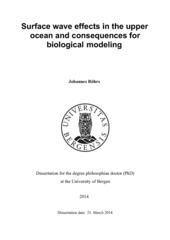| dc.contributor.author | Röhrs, Johannes | eng |
| dc.date.accessioned | 2014-04-03T15:26:08Z | |
| dc.date.available | 2014-04-03T15:26:08Z | |
| dc.date.issued | 2014-03-21 | eng |
| dc.identifier.isbn | 978-82-308-2956-1 | en_US |
| dc.identifier.uri | https://hdl.handle.net/1956/7897 | |
| dc.description.abstract | Effects of surface gravity waves on particle transport and currents in the upper ocean are studied using field observations and numerical models. Knowledge on upper ocean particle drift is needed for plankton transport studies, search- and rescue operations and oil drift modelling. Such applications depend on upper ocean currents on time scales from hours up to several months, and surface gravity waves affect the air-sea momentum exchange particularly on these time scales. Objects near the surface are also exposed to the wave-induced Stokes drift, which moves particles in the wave propagation direction at a speed with similar magnitude as the Eulerian current. Surface waves furthermore modify the Eulerian mean currents by momentum release during wave breaking and the dissipation of wave energy into oceanic turbulence. Measurements of upper ocean currents, surface drifters, and waves were taken during field campaigns in Northern Norway. Ocean currents from acoustic Doppler current profilers, high-frequency (HF) radars and satellite-tracked surface drifters were synthesized with wave measurements to separate the Eulerian currents from the Lagrangian, their difference is the Stokes drift. The contribution of waves to surface drifter velocities and observed HF radar currents was quantified and compared with theoretical concepts from the literature. The surface drifters followed the sum of Eulerian currents and Stokes drift with little wind drag. In contrast to previous assumptions, the observation showed that HF radar-derived currents do not include the Stokes drift. The observations were also used to quantify the momentum and energy fluxes from waves into the ocean during a wind event. The wave-induced drift of suspended plankton was investigated for the example of Northeast Arctic (NEA) cod eggs. Their physical properties are relatively well known, providing a practical example for biological models that depend on oceanic circulation. A combined ocean circulation model, wave model and particle tracking model is used to model pathways of cod eggs from their spawning grounds towards nursery grounds. The cod eggs are affected by (i) the Stokes drift; (ii) the wave-induced forcing on Eulerian mean currents; and (iii) the turbulent mixing induced by breaking waves. Accounting for wave effects in the model system yields more accurate drift velocities and vertical particle distributions compared with observations. Waves are shown to significantly affect the fate of NEA cod eggs: The Stokes drift causes a shoreward flux of particles and thereby reduces the alongshore transport causing retention of NEA cod eggs and larvae around the spawning grounds. The discussed wave effects generally apply to all plankton in the pelagic layer. The Stokes drift contributes significantly to the fate of drifting particles in the long term because it exhibits a horizontally more uniform direction than the Eulerian currents. The wave field varies on the scales from the atmospheric forcing, giving better predictability than ocean currents. Including wave effects in models therefore facilitates better forecast skills of surface drift applications. | en_US |
| dc.language.iso | eng | eng |
| dc.publisher | The University of Bergen | en_US |
| dc.relation.haspart | Paper 1: Observation-based evaluation of surface wave effects on currents and trajectory forecasts. Johannes Röhrs, Kai Håkon Christensen, Lars Robert Hole, Göran Broström, Magnus Drivdal and Svein Sundby. Ocean Dynamics 62, 1519–1533, 2012. The article is not available in BORA due to publisher restrictions. The published version is available at: <a href="http://dx.doi.org/10.1007/s10236-012-0576-y" target="blank">http://dx.doi.org/10.1007/s10236-012-0576-y</a> | en_US |
| dc.relation.haspart | Paper 2: Wave induced transport and vertical mixing of pelagic eggs and larvae. Johannes Röhrs, Kai Håkon Christensen, Frode Vikebø, Svein Sundby, Øyvind Sætra and Göran Broström. The article is not available in BORA. | en_US |
| dc.relation.haspart | Paper 3: Surface wave measurements using a ship-mounted ultrasonic altimeter. Kai Håkon Christensen, Johannes Röhrs, Brian Ward, Ilker Fer, Göran Broström, Øyvind Sætra and Øyvind Breivik. Methods in Oceanography 6, 1–15, 2013. The article is not available in BORA due to publisher restrictions. The published version is available at: <a href="http://dx.doi.org/10.1016/j.mio.2013.07.002" target="blank">http://dx.doi.org/10.1016/j.mio.2013.07.002</a> | en_US |
| dc.relation.haspart | Paper 4: Comparison of HF radar measurements with Eulerian and Lagrangian surface currents. Johannes Röhrs, Ann Kristin Sperrevik, Kai Håkon Christensen, Göran Broström and Øyvind Breivik. The article is not available in BORA. | en_US |
| dc.title | Surface wave effects in the upper ocean and consequences for biological modeling | en_US |
| dc.type | Doctoral thesis | |
| dc.rights.holder | Copyright the author. All rights reserved | en_US |

